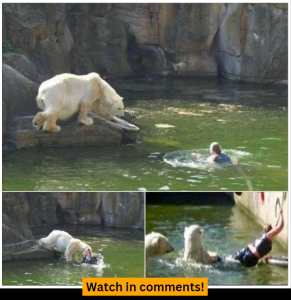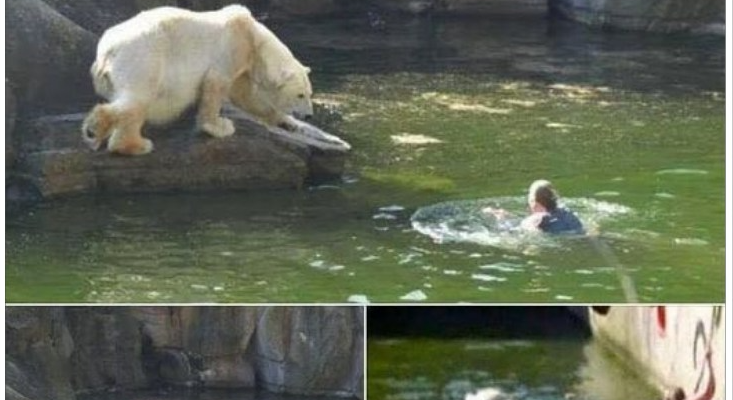
A Leap Into Danger: The Berlin Zoo Polar Bear Incident
On April 10, 2009, a shocking and surreal event unfolded at the Berlin Zoological Garden, one of Germany’s most renowned zoos. During the busy Easter holiday weekend, a 32-year-old woman inexplicably climbed over multiple barriers and jumped into the polar bear enclosure—just as the animals were being fed. What followed was a terrifying encounter that left the woman severely injured and raised serious questions about mental health, public safety, and the boundaries between humans and wildlife.
The Setting
Berlin Zoo is home to a wide array of animals, but few are as iconic—or as dangerous—as the polar bears. These powerful predators, native to the Arctic, are known for their strength, speed, and unpredictability. The enclosure housing them is designed with safety in mind: a high fence, a deep moat, and a rocky island where the bears roam. Visitors can observe from a distance, separated by multiple layers of protection.
On that fateful Friday, the zoo was crowded with families enjoying the spring weather. The polar bear feeding session was a popular attraction, drawing dozens of spectators to the enclosure. Among them was the woman who would soon become the center of a global media storm.
The Jump
Without warning, the woman climbed over the outer fence and dropped into the 10-foot-deep moat that surrounds the polar bear habitat. Witnesses watched in horror as she swam toward the bears, who were focused on their food. Her motives were unclear—some speculated she was mentally unstable, others believed she was attempting a stunt or seeking attention.
The timing couldn’t have been worse. Feeding time is when the bears are most active and alert. As the woman approached, one of the bears—later identified as Lars—noticed her presence and moved toward the water’s edge.
The Attack
What happened next was both terrifying and tragic. Lars lunged at the woman, biting her on the arms, legs, and back. She screamed and struggled to escape, but the bear’s powerful jaws clamped down repeatedly. Zookeepers rushed to the scene, using poles and other tools to distract the bear and pull the woman to safety.
Photographs captured the dramatic rescue: the woman bleeding, her face contorted in pain, as staff members reached into the enclosure to drag her out. She was rushed to a nearby hospital with serious injuries, including deep bite wounds and lacerations. Miraculously, she survived.
Public Reaction
The incident sparked immediate outrage and disbelief. How could someone breach the enclosure so easily? Why would anyone willingly enter a habitat housing one of the world’s most dangerous animals?
Zoo officials emphasized that the barriers were secure and met international safety standards. The woman had deliberately bypassed multiple layers of protection, including warning signs and fences. Still, the event prompted a review of security protocols and raised questions about mental health, public safety, and the responsibilities of zoos in preventing such incidents.
Visitors expressed a mix of horror and sympathy. “It was the most terrifying thing I’ve ever seen,” said one witness. “She was so close to death. I still can’t believe she survived.” Others criticized the woman’s recklessness, arguing that her actions endangered not only herself but also the animals and staff.
Legal and Ethical Questions
Legally, the woman faced no charges. Her injuries were deemed punishment enough. But the incident reignited debates about liability and ethics. Should zoos be held accountable for breaches, even when caused by deliberate trespassing? Should individuals be prosecuted for endangering themselves and others?
Animal rights activists weighed in, concerned about the stress inflicted on the bears. “These animals are already living in captivity,” one activist noted. “Now they’re being provoked and punished for behaving naturally.” Fortunately, Lars was not harmed or relocated, but the incident served as a cautionary tale about human-animal boundaries.
Media Sensation
The story made international headlines. Tabloids dubbed it “The Polar Bear Mauling,” while news outlets dissected every angle—from enclosure design to the woman’s psychological profile. Videos and photos of the attack circulated online, drawing millions of views and sparking debates about voyeurism and ethics in media coverage.
Some criticized the sensationalism, arguing that the focus should be on prevention and education rather than spectacle. Others saw the incident as a wake-up call—a vivid reminder of nature’s power and the importance of respecting wildlife.
Mental Health Dimensions
Though the woman’s identity was not widely disclosed, reports suggested she may have been suffering from mental health issues. Her decision to jump into the enclosure defied rational behavior, and experts speculated about possible delusions or suicidal intent.
This raised broader questions about mental health awareness and support. How do public spaces like zoos prepare for unpredictable human behavior? Should there be more visible security or mental health interventions in crowded venues?
Lessons Learned
The Berlin Zoo incident is more than a bizarre news story—it’s a case study in human behavior, safety design, and the unpredictable nature of wildlife. It underscores several key lessons:
- Respect for Boundaries: Wild animals, even in captivity, are not pets. They retain their instincts and can be deadly.
- Mental Health Awareness: Public spaces must be equipped to handle crises, including those stemming from psychological distress.
- Zoo Safety Protocols: While the enclosure met standards, the incident prompted a reevaluation of barriers, signage, and surveillance.
- Media Responsibility: Coverage should inform and educate, not exploit trauma for clicks and ratings.
Broader Implications
This event also touches on philosophical questions about human curiosity and risk. What drives someone to confront danger head-on? Is it thrill-seeking, desperation, or something deeper?
In literature and history, humans have always tested boundaries—from Icarus flying too close to the sun to explorers venturing into the unknown. The Berlin Zoo incident is a modern echo of that impulse—a reminder that curiosity, when unchecked, can lead to catastrophe.
Conclusion
The woman who entered the polar bear enclosure at Berlin Zoo survived a near-death experience that captivated the world. Her story is one of recklessness, resilience, and reflection. It challenges us to think about safety, empathy, and the fragile line between civilization and nature.
As zoos continue to evolve, incorporating more naturalistic habitats and interactive experiences, the need for vigilance grows. Visitors must understand that these spaces, while educational and entertaining, house creatures whose instincts cannot be tamed. And society must ensure that those struggling with mental health receive the support they need—before tragedy strikes.

